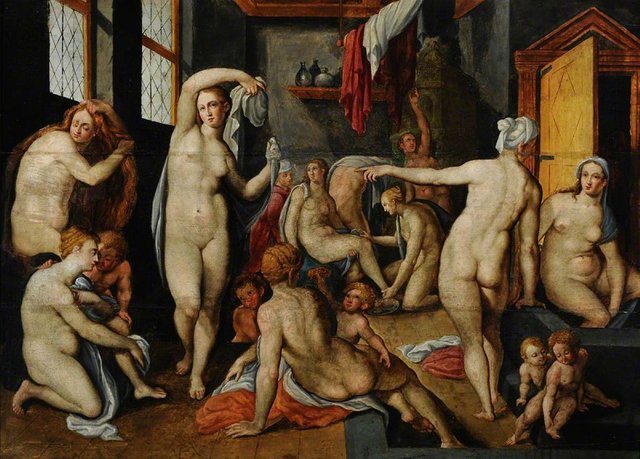The school in Fontainebleau - The phrase is used for the first time by Viennese writer and engraver Adam von Barch in the sixteenth volume of his Inventory of Artists and Engravers in Europe, which appeared in Vienna in 1821. It was used to mark the series of engraved prints made in Fontainebleau between 1542 and 1548, following the Italian model of etching used for the first time by the Italian artist Francesco Mazola, known as Parmesan (1503-1540). In the second half of his reign, François I redirects his attention to the building of his residence near Fontainebleau, the construction of which is used by the Italian renaissance builders. The King invites to Fontainebleau already famous Italian masters, sculptors, painters and decorators, such as Celine, Primacio, Rosso and Leonardo da Vinci, who died in France in 1519. Yes, Vinci probably helped the patron king with his own project on Shambhur Castle. The French kings have attracted more artists in their castles whose masterpieces were admired in Italy: they often bought their sails, Pierre Michel witnesses. François I had acquired Leonardo's "Gioconda". He also bought the artist who had to spend the rest of his life in the palace ... The Florentine Benvenuto Chelins made for François I his "Nymph" from Fontainebleau, intended for the castle of Anne. Many of the gold jewelery made by him on the order of the King are now kept in the Louvre. It was the Italians that it was thanks to the patronage that they gave the artist a kind of social status .
The master craftsmen and engravers are the first to be called by King Francois I as early as 1531 to decorate his apartments in Fontainebleau Castle. This group is the nucleus around which the Fontainebleau School will be constituted and expanded. Among the engraving masters, we should mention Antonio Fantucci, author of Mars and Venus in the Bathroom, Master L.D., created "Jason Kills the Dragon," and Jean Million, who made the "Acteon Turnover." They work by following the patterns and guidance of the well-established Italian artists such as Rosso, Primaccio and Luca Penny. We can not overlook all three tapestry makers Geoffrous Dumitre, Leonar Limuzen and the strange Righteous of the Righteous, who is the author of the eccentric composition "Pyramids of naked men". The first of the Italian Renaissance painters, who responded to Francois I's invitation to come to work in the castle near Fontainebleau, was the Florentine Giovanni Battista di Jacopo de Rossi, who became famous under the pseudonym Rosso (1494-1540). He is preparing as a painter at the Michelangelo school in Rome, but he is in the service of the French King as "Head of Sculptures and the Painting of the Central Gallery". Rosso remains at the end of his life for the interior decoration of this gallery, which begins to be called "Francois I". His chief assistant became Flemish artist Leonard Tirrie. All the stories about the compositions on the walls and ceilings are borrowed from ancient Greek mythology: "The Death of Adonis," The Burning of Troy, "The Battle between the Centaurs and the Lapiths." Each combination is framed by the sculptural sculptures made by the famous marble dust and gypsum masters, Lorenzo Naldino, Domenico del Barbière, Francois of Orleans and Simon of Paris, who have put all their talent in them.
On the recommendation of the student and co-worker of Rafaello Giulio Romano, who has won Francois I's trust, the famous Bologna painter Francesco Primaccio was invited to Fontainebleau. Priamoo devoted almost forty years of his life to the beautification of the famous castle of the highly educated French king. He and his assistants work at the same time in Fontainebleau, where he works with his team of collaborators and Rosso, but the two Italian masters prefer to paint in a strictly detached room for their talent in the grand royal residence. After the death of Roso Primaccio, he was appointed Chief Director for the maintenance of the buildings in Fontainebleau. Under his leadership, artists Luca Penny, Antoine Caron, Jean and Simon Corney, sculptors Pierre Bonton, Shibek de Carpi, Julio de Troia and many other woodcarvers and mosaics are working. Primotico's picturesque strategy is clearly influenced by Julio Romano's guidance and by the in-depth study of Cordage's technique and, above all, the paintings of Parmesan. He is the author of 171 compositions found in the Odysseus Palace Gallery, which inspired the generations of painters who appeared in the course of the 17th century in France. During the reign of Louis XV, this gallery was destroyed, and much of Primacio's works did not reach us.

Downvoting a post can decrease pending rewards and make it less visible. Common reasons:
Submit
Downvoting a post can decrease pending rewards and make it less visible. Common reasons:
Submit
You got a 9.61% upvote from @postpromoter courtesy of @godflesh!
Want to promote your posts too? Check out the Steem Bot Tracker website for more info. If you would like to support the development of @postpromoter and the bot tracker please vote for @yabapmatt for witness!
Downvoting a post can decrease pending rewards and make it less visible. Common reasons:
Submit